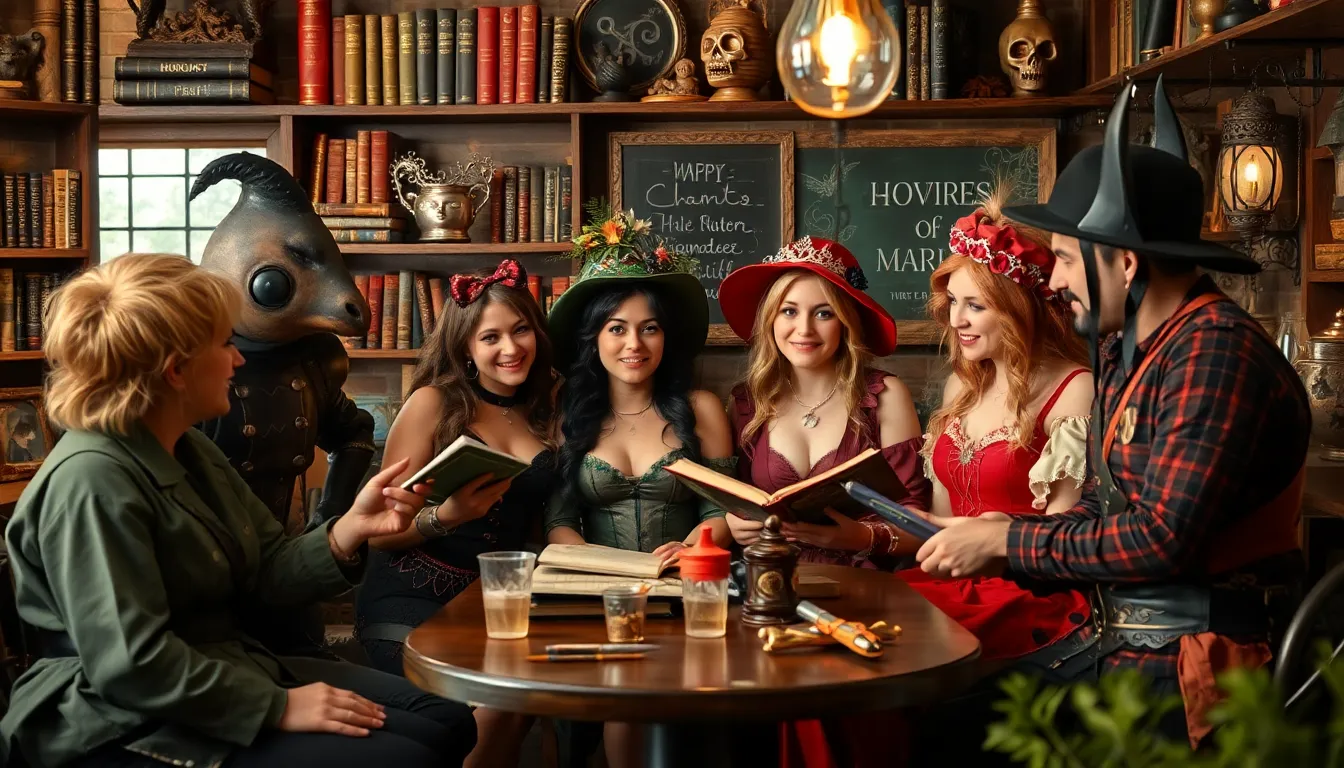Every story has its quirks, and genre-specific tropes are like the secret sauce that makes them unforgettable. Whether it’s the brooding hero in a romance or the quirky sidekick in a comedy, these familiar patterns draw readers in and keep them hooked. But let’s face it—some tropes are as comforting as a warm blanket, while others might make you roll your eyes so hard you see your brain.
Table of Contents
ToggleUnderstanding Genre-Specific Tropes
Genre-specific tropes serve as familiar markers within storytelling, guiding readers through narratives. They establish expectations and shape the audience’s experiences. For instance, the brooding hero trope resonates deeply in romance novels, creating an emotional pull that enhances connection. Clichéd tropes, on the other hand, like the misunderstood villain, may evoke irritation among readers.
The role of these tropes extends beyond mere familiarity; they facilitate storytelling by providing structure. Many genres utilize common themes, such as the chosen one in fantasy or the fish out of water in comedy. Each trope enriches narratives, making them memorable.
Diversity in tropes exists, allowing for innovation within the framework of established patterns. Combining multiple tropes can lead to fresh and engaging plots. Readers expect and often crave these genre markers, as they contribute to what makes a story enjoyable.
Critically, some tropes carry cultural significance, influencing perceptions and character archetypes. As a result, writers must wield them thoughtfully. Recognizing the fine line between comfort and predictability helps in crafting compelling stories. By embracing genre-specific tropes, authors can balance familiarity and originality effectively, ensuring their tales resonate without feeling stale.
Utilizing tropes wisely enhances character development, plot progression, and overall impact. Each genre thrives on these devices, shaping the reader’s journey while maintaining engagement. Understanding the nuances of genre-specific tropes elevates storytelling, making narratives riveting and unforgettable.
Common Tropes in Popular Genres

Genre-specific tropes shape narratives and influence audience expectations. Each genre features unique patterns that resonate with readers.
Fantasy Genre Tropes
Chosen one narratives often dominate fantasy, where unlikely heroes embark on epic quests. Magical artifacts serve as critical plot devices, granting characters power or knowledge. Engaging mentor figures guide protagonists, imparting wisdom essential for their journeys. Conflicted alliances introduce tension, as characters navigate complex relationships among friends and foes. These common tropes create familiar ground for exploration and adventure.
Romance Genre Tropes
The enemies to lovers dynamic captures attention, transforming initial antagonism into romance. Misunderstandings often drive conflict, leading to heartwarming resolutions. Love triangles stir emotions, complicating relationships and challenging characters’ decisions. Small-town settings evoke a sense of nostalgia, placing characters in environments that foster connections. These tropes enhance emotional stakes, keeping readers invested in the love stories.
Horror Genre Tropes
The final girl trope features a lone survivor facing the antagonist, showcasing resilience amid chaos. Jump scares and suspenseful builds heighten tension, creating a thrilling atmosphere. Isolated settings frequently amplify fear, trapping characters in vulnerable situations. Supernatural forces often spiral narratives, introducing uncertainty that keeps readers on edge. These elements contribute to the genre’s ability to terrify and captivate audiences.
The Impact of Tropes on Storytelling
Tropes significantly affect storytelling by shaping reader expectations and guiding narrative structures. Recognizing their role enhances the creation of engaging plots.
Reader Expectations
Tropes establish clear expectations for readers, facilitating an immediate understanding of the story’s direction. Common themes like the hero’s journey in fantasy or the meet-cute in romance create frameworks that readers find familiar and comforting. Viewers often approach a new story with preconceived notions based on these patterns, leading to a quicker emotional investment. While this familiarity invites engagement, it can also produce disappointment when expectations aren’t met, especially in genres with strong conventions. Writers must balance delivering satisfying tropes and maintaining freshness to keep audiences captivated.
Creative Limitations
Tropes provide both structure and boundaries for writers. While these familiar elements simplify the storytelling process, they sometimes inhibit creativity by confining narratives within predictable patterns. The reliance on clichéd tropes risks rendering stories unoriginal, leading to viewer disinterest. However, skilled authors can utilize tropes strategically, twisting or subverting them to surprise readers. Innovations achieved through unique combinations of tropes can lead to original plots, ensuring fresh experiences for the audience. Understanding the delicate balance between utilizing established tropes and fostering originality ultimately enhances narrative depth.
Subverting Genre-Specific Tropes
Subverting genre-specific tropes introduces fresh perspectives and keeps narratives engaging. Authors challenge audience expectations, incorporating unexpected twists that breathe new life into familiar patterns. Combining certain tropes in unanticipated ways captivates readers and creates memorable stories.
An example of subverting tropes in fantasy occurs when a seemingly ordinary character, not the anticipated “chosen one,” emerges as the hero. This shift surprises readers, offering a more relatable protagonist. Similarly, romance plots benefit from flipping the “enemies to lovers” trope by revealing deeper emotional connections earlier in the narrative, diverging from traditional buildup.
In horror, employing the final girl trope as a villain invites viewers to reassess assumptions. Audiences find it unsettling yet intriguing when the apparent hero embodies traits typically associated with antagonists. Comedic narratives also succeed in subverting expectations; characters who break the fourth wall can lead to unexpected and engaging humor.
Genre awareness equips writers with tools to embrace or challenge these conventions. Understanding how to manipulate audience assumptions fosters originality while keeping narratives grounded. Balancing genre conventions and fresh ideas ensures that stories resonate with readers without falling into predictable formulas.
Writers can explore cultural implications by reimagining tropes to reflect contemporary issues. Such subversions enhance relevance within modern contexts, allowing characters to feel authentic and engaging. By thoughtfully navigating genre-specific tropes, authors create dynamic narratives that surprise and delight their audiences, enhancing emotional investment and satisfaction.
Genre-specific tropes play a crucial role in shaping narratives and influencing audience engagement. By understanding these familiar patterns, writers can craft stories that resonate deeply with readers while balancing originality and expectation. The potential for innovation lies in the thoughtful combination or subversion of these tropes, allowing for fresh storytelling experiences.
As authors navigate the landscape of genre conventions, they can create dynamic plots that surprise and captivate. Embracing the power of tropes not only enhances emotional investment but also enriches the overall storytelling experience. With careful consideration, writers can transform traditional narratives into compelling journeys that leave a lasting impact on their audience.









